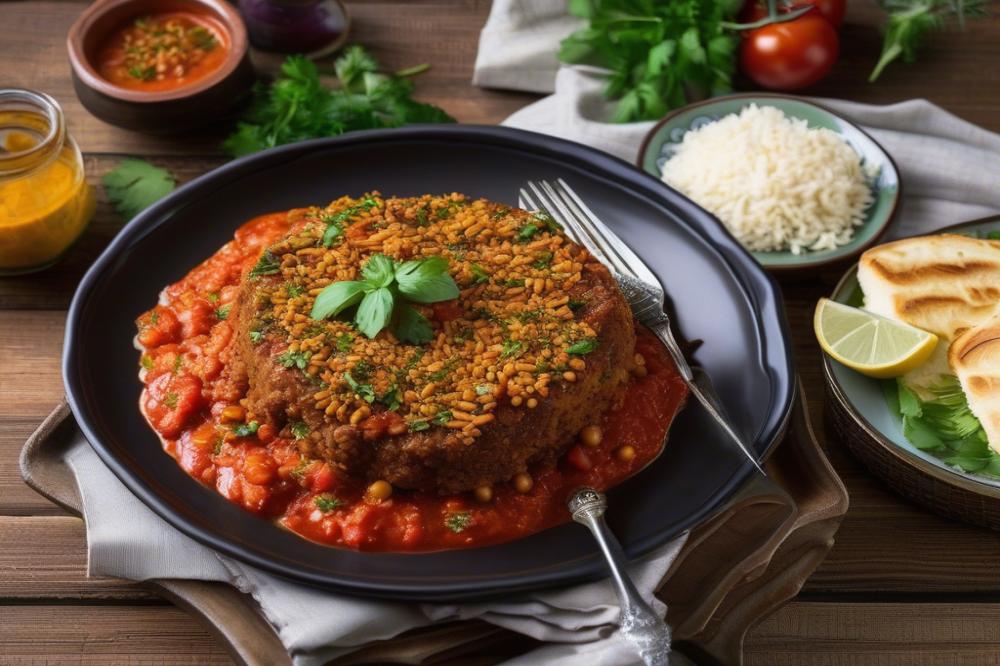Classic Moroccan traditional-moroccan-couscous”>Harira: A hearty Soup for Every Occasion
traditional-moroccan-couscous”>Harira is a beloved traditional Moroccan soup that embodies warmth and richness. It combines a variety of ingredients, making it both filling and comforting. Recipes for this hearty dish often include tomatoes, lentils, and chickpeas. These elements create a unique balance of flavors and textures. Spices add another layer of depth, enhancing its character.
This soup holds a special place in Moroccan culture, especially during Ramadan. Families gather to break their fast with a steaming bowl of Harira. It symbolizes unity and generosity, shared amongst friends and loved ones. The tradition of preparing this Moroccan soup brings people together, fostering community spirit.
Not limited to Ramadan, Harira serves various occasions throughout the year. Its adaptability allows cooks to modify the recipe according to personal taste or the season. Some may choose to add more vegetables or experiment with different spices. Regardless of the variations, it remains a cherished comfort food that satisfies both the body and soul.
What is Harira?

Harira is a hearty soup that holds a special place in Moroccan cuisine. Often enjoyed during special occasions, it is rich in flavor and nutrition. This traditional dish is made with a base of tomatoes, filled with lentils, chickpeas, and various spices. Each bowl offers warmth and comfort, making it a favorite for many. Many families gather around a pot of this delicious soup, especially during Ramadan.
The role of harira in Moroccan culture goes beyond mere sustenance. Its preparation is often a family affair, bringing people together. When the sun sets during Ramadan, this soup acts as a welcoming treat to break the fast. Its comforting nature nurtures both the body and spirit, providing a sense of home wherever it is served.
Regional variations add to its charm and cultural significance. Each area of Morocco may have its own unique recipes, incorporating different spices or additional ingredients. For some, adding vermicelli provides a delightful twist, while others might emphasize certain herbs. This adaptability showcases how cultural dishes evolve, while still keeping the essence of comfort food. Harira is more than a meal; it is a reflection of tradition and a celebration of community.
Ingredients and Cooking Instructions

List of Ingredients with Quantities
- 1 cup lentils
- 1 cup chickpeas (cooked)
- 1 large onion, chopped
- 2 cups diced tomatoes (fresh or canned)
- 1/2 cup chopped celery
- 1/2 cup chopped parsley
- 1/2 cup chopped cilantro
- 1 tsp ground ginger
- 1 tsp ground cumin
- 1 tsp turmeric
- 1/2 tsp cinnamon
- 7 cups vegetable or chicken broth
- Salt and pepper to taste
- 3 tbsp olive oil
- Lemon wedges for serving
Step-by-Step Cooking Instructions
Start by heating the olive oil in a large pot. Add the chopped onion and cook until it becomes soft and translucent. This usually takes about five minutes. Stir in the spices: ginger, cumin, turmeric, and cinnamon. The aroma of these spices will fill your kitchen as they sauté together.
Next, add the diced tomatoes into the pot. Fresh ones will give a brighter flavor, but canned tomatoes work just as well. Pour in the vegetable or chicken broth, allowing the mixture to come to a simmer. Make sure everything is well combined before proceeding.
Once bubbling, incorporate the lentils and cooked chickpeas. These ingredients will add heartiness, making this dish filling and nutritious. Let it simmer on low heat for about 30 to 40 minutes. This time helps rich flavors to develop as the lentils also get tender.
After simmering, check the consistency. If it’s too thick, adding more broth can help. Season with salt and pepper to taste. Finally, before serving, stir in the chopped celery, parsley, and cilantro. These herbs provide a fresh touch, balancing the warmth of the spices.
For serving, ladle the soup into bowls and include lemon wedges on the side. A squeeze of lemon can brighten the flavors beautifully. This traditional recipe is perfect comfort food, especially during Ramadan or any chilly day.
Nutritional Information for Each Ingredient
- Lentils: Rich in protein and fiber, they also contain iron and B vitamins.
- Chickpeas: A great source of protein, fiber, and important vitamins like folate.
- Onion: Contains antioxidants and can have anti-inflammatory effects.
- Tomatoes: High in vitamins C and K, as well as potassium.
- Celery: Low in calories, and offers dietary fiber and vitamins A and K.
- Parsley: Packed with vitamins C, K, and A, it also has antioxidants.
- Cilantro: Provides vitamin K and is known for its detoxifying properties.
- Spices: Each contributes unique health benefits, from anti-inflammatory to antioxidant properties.
- Broth: Depending on whether vegetable or chicken, it adds important flavors and nutrients.
- Olive oil: A healthy fat that can enhance heart health.
Cultural Significance of Harira

The role of Harira during Ramadan cannot be overstated. This hearty soup becomes a daily meal to break the fast. Families gather eagerly at sunset to share this special dish. The aroma fills homes, inviting everyone to the table. It symbolizes the end of each fasting day and the beginning of togetherness.
Every spoonful of Harira tells a story of tradition and love. Often, recipes are passed down through generations. Each family may have its own unique spin, reflecting regional tastes. Chickpeas, lentils, and tomatoes mingle with spices, creating a comforting blend. This rich combination not only nourishes the body but also the spirit.
Communities also come together to enjoy this cultural dish. Celebrations often revolve around shared meals, strengthening bonds among neighbors. Offering Harira is a gesture of hospitality for many Moroccans. Guests receive a bowl with warmth and enthusiasm. It shows deep respect for those who gather to celebrate life’s moments.
This soup serves as a reminder of Morocco’s rich culinary heritage. The vibrant flavors and textures reflect the country’s diverse history. Many view it as comfort food, bringing solace during challenging times. Harira embodies both celebration and sustenance, making it a cherished part of Moroccan life.
Variations and Adaptations
Across Morocco, each region presents its own take on this traditional soup. In coastal areas, you might find more seafood incorporated, capturing the flavors of the ocean. Inland regions often emphasize meat, using lamb or beef to enhance the dish’s heartiness. Chickpeas and lentils remain staples, but local variations can introduce additional legumes or grains, offering unique textures.
For those who prefer plant-based meals, vegetarian and vegan adaptations are widely celebrated. Omitting meat doesn’t compromise flavor. Rich vegetable stocks can replace meat broth, while spices like cumin, coriander, and cinnamon add warmth and depth. Tomatoes serve as a base, bringing both acidity and sweetness to balance the spices. Furthermore, incorporating extra legumes lets chefs create a dish that is both robust and nutritious.
Seasonal ingredients can transform the classic recipe, making it perfect for any occasion. In spring, fresh herbs like parsley and cilantro can brighten the dish. While in fall, root vegetables such as carrots or sweet potatoes can be included for a comforting twist. These adjustments allow the soup to reflect what is available locally and at different times of the year.
During Ramadan, this dish holds a special place as a beloved comfort food. Each family may have their own recipes passed down through generations, incorporating spices that evoke memories. Customizing harira provides both a connection to heritage and an opportunity to explore new flavors.
Final Thoughts on Harira
Recapping the importance of this traditional soup reveals its role as a beloved dish in Moroccan culture. Many families cherish this hearty meal, especially during Ramadan, when it breaks the fast. Not only is it filling, but it also brings people together. You can often find it served at gatherings, celebrations, and even on ordinary days.
Trying to make this dish at home can be an exciting adventure. With its rich flavors and comforting ingredients, preparing it can create warm memories in the kitchen. Following a simple recipe is all that is needed. Experiment with spices and textures to make it your own. Every attempt could lead to new variations, making the experience enjoyable.
Many find that nothing beats a warm bowl of this soup on a chilly day. It has a unique way of lifting spirits and satisfying hunger. Sharing it with family and friends can turn any meal into a special occasion. The lasting appeal lies in its ability to adapt to any situation, from festive gatherings to quiet dinners. Enjoying homemade soup can bond people together, making it a cherished staple for everyone.



